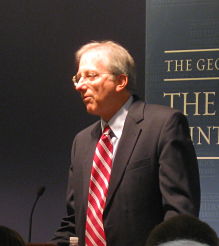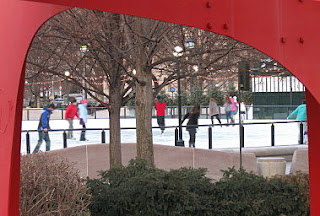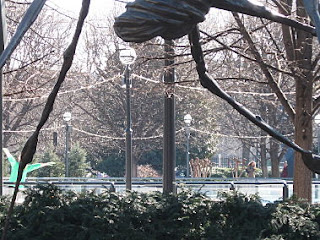The Pentagon Memorial/Photo by Patricia Leslie
Have you been? Is there any memorial which is more uninspiring?
What is the difference between a memorial and a cemetery? The Pentagon Memorial dedicated to the 184 victims of the September 11 plane crash at the Pentagon is certainly not a place to visit for hope or encouragement.
It is not a structure which adequately pays tribute to and memorializes those who died on that wrenching day.
It is a monument with no link to the strong and energetic nation which briefly united and came together to work to fight evil.
When you stand and look at the Pentagon wall which the American Airlines jet struck, the memory of the photograph forever etched on your mind comes into immediate view: the firemen and rescue workers unfurling the gigantic American flag down the side of the building.
Where is that spirit that energized the nation?
It is not to be found at the stone and gravel heap which sits below the once damaged wall.
The Pentagon Memorial is a cemetery on a faraway, barren planet.
The Pentagon Memorial looking toward Crystal City/Photo by Patricia Leslie
Rather than celebrating the lives of those who died in the Pentagon crash, its effect leaves a visitor dispirited and unmoved.
What a contrast to the arrival of springtime in Washington, D.C. with colors bursting out all over the city.
What a contrast to Arlington Memorial Cemetery with its evergreens and grass.
What a contrast to the soaring Air Force Memorial on the hill nearby which lifts a viewer higher and higher into the great beyond of exploration and wonder until the mind returns to earth and realizes the ground beneath is a paved graveyard on a desert of brown and grey pebbles.
In the distance (center) is the Air Force Memorial/Photo by Patricia Leslie
In the distance (center) is the Air Force Memorial/Photo by Patricia Leslie
A stainless steel bench, a "memorial unit," not intended for seating, is dedicated to each victim. The benches are built over small rectangular pools of flowing water and pointing in one of two confusing directions. Their design suggests buried tails or rudders of airplanes. A suitable reminder?
Depending upon whether the victim was at the Pentagon that day, a bench with the victim's name points towards the building, and if the victim was on the plane, the bench points to the plane's path into the Pentagon. The names of family members who also died at the Pentagon September 11 are listed at each bench, but their names are obscured by scattered pebbles which have been kicked and blown into the water.
 Family members of Zoe Falkenberg whose names are obscured by pebbles, all September 11 victims of the Pentagon crash/Photo by Patricia Leslie
Family members of Zoe Falkenberg whose names are obscured by pebbles, all September 11 victims of the Pentagon crash/Photo by Patricia Leslie
Years of birth segregate the victims (aged 71 to three years). How are their ages related to the events of September 11, 2001? They didn't die based on their ages.
This memorial seeks to accomplish too much and fosters confusion.
Of 20 or so area residents I queried about trips to the memorial, only one area resident had visited, and her assessment matched ours ("bland" and "lifeless"). Remarks at Yelp show some of the same impressions. Compare residents' lack of interest in the Pentagon Memorial to those who have visited the Martin Luther King, Jr. Memorial which opened last fall, more than three years after the dedication of the Pentagon Memorial on September 11, 2008.
It is time to change the ineffectual design and make it more than the concrete cemetery it is now.
How much would it cost to change the pebbles for grass which would not hide family names and would offer a respite of color?
How much would it cost to plant flowers?
Private donations could fund expenses. Rather than dead bushes and trees which show no life for much of the year, what about evergreens which are...ever green?
Eighty-five trees, dedicated to no one, says an information sheet, will eventually provide a canopy of shade over the site, but for now, they are long sprouting sticks in a grey, monotonous mass of desolation.
Perhaps the only time to visit this memorial is at night when darkness hides the drab grey and brown landscape, and reflected light offers glimmers of life
beyond.
The "Memorial Unit" or bench dedicated to Zoe Falkenberg, age 8/Photo by Patricia Leslie
At the entrance to the Pentagon Memorial/Photo by Patricia Leslie
The September 11, 2001 victims of the Pentagon crash/Photo by Patricia Leslie


















 Hermann Stilke (1803-1860). Joan of Arc's Death at the Stake (1843) Hermitage Museum, St. Petersburg/Wikimedia Commons
Hermann Stilke (1803-1860). Joan of Arc's Death at the Stake (1843) Hermitage Museum, St. Petersburg/Wikimedia Commons



.jpg)

.jpg)








